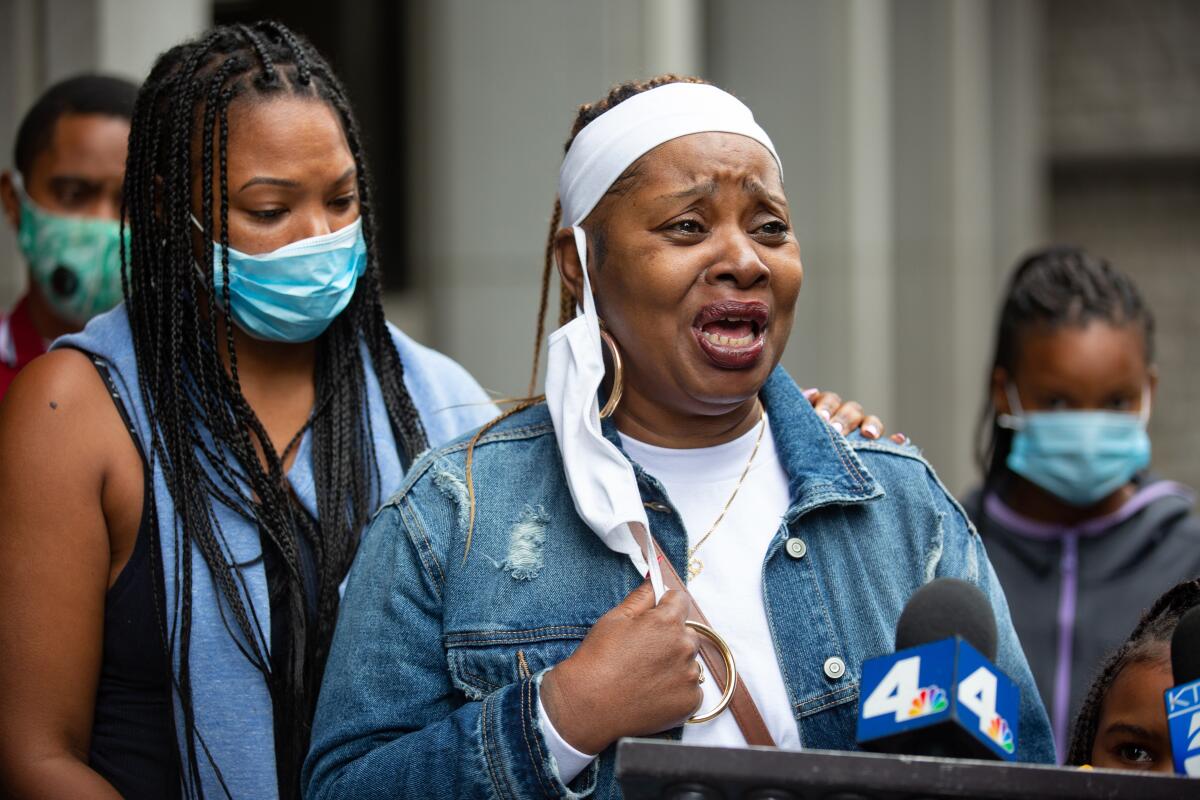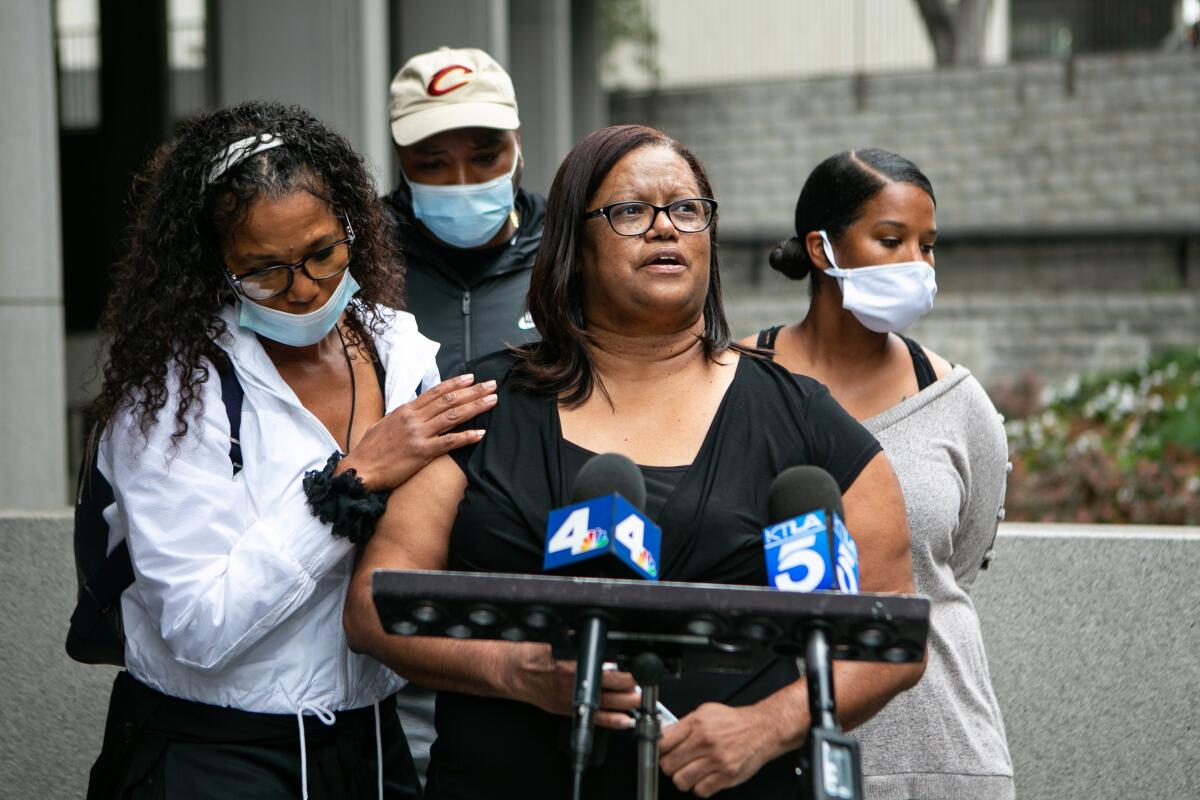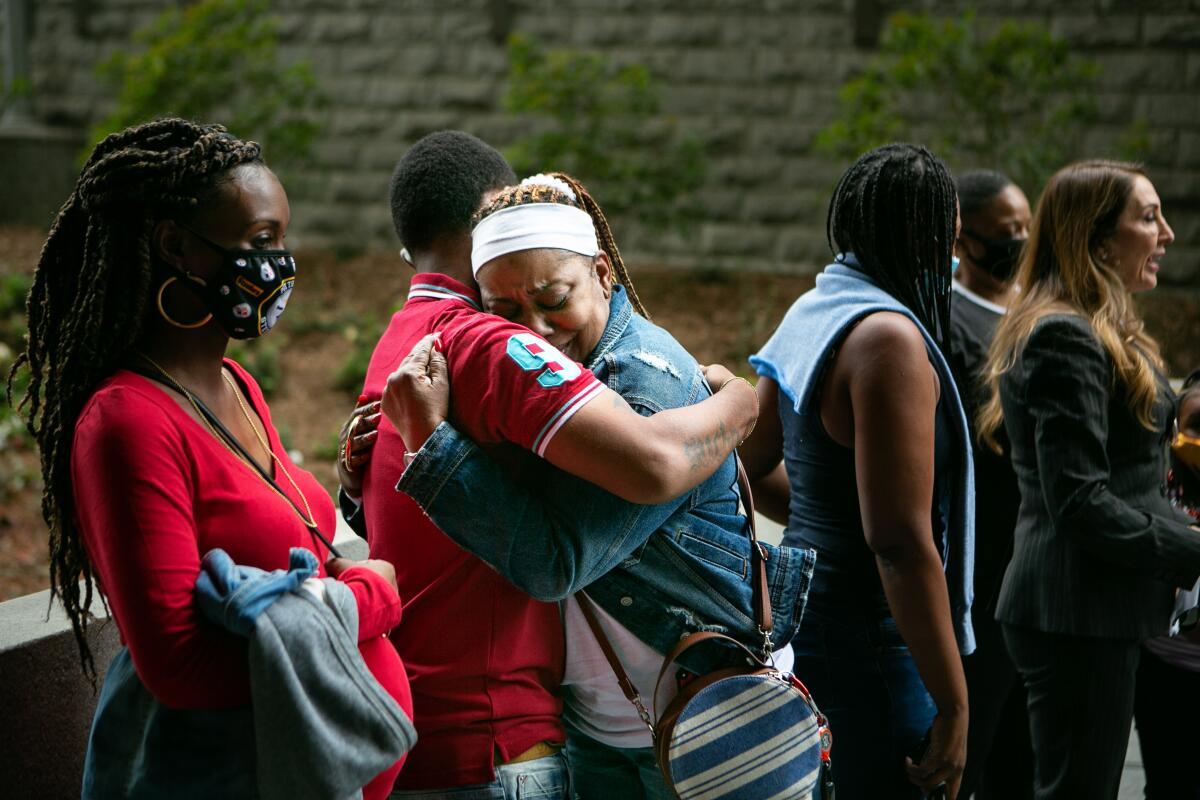Two Black men sentenced to life as teens to be freed. But should L.A. County D.A. have reviewed convictions earlier?

- Share via
When the shots rang out, Dupree Glass said he did what came naturally and dropped to the ground.
A teen at the time, Glass admits he had gone to the house in Lancaster that night in 2004 for a fight. But he said he was only there to trade punches, not gunfire.
Seconds later, Glass says he hopped up, checked to see if any of his friends were hurt, and fled.
Ten days later, Glass said he saw his picture on a wanted flier for attempted murder. Ten months after that, a judge told him he’d spend the rest of his life in prison.
Glass and his co-defendant, Juan Rayford, have long maintained their innocence. There was no physical evidence tying them to the shooting, and their conviction relied heavily on the testimony of just two witnesses.
Their convictions were vacated by an appellate court earlier this year after a 2019 California Supreme Court decision severely narrowed the use of “kill zone” prosecutions, which allowed prosecutors to charge the teens with the attempted murder of everyone in range of the gunfire. Despite the fact that only two people were hurt that night, Glass and Rayford were convicted of 11 counts of attempted murder.
While their release was secured due to the change in the law, the Los Angeles County district attorney’s office has been aware of witness statements raising doubt about Glass and Rayford’s guilt for at least five years, and their case has reinvigorated criticisms of the office’s dedication to reviewing the integrity of past convictions.
During a years-long investigation, Laguna Beach attorney Annee Della Donna and retired Los Angeles Police Department Lt. Dan Mulrenin found multiple witnesses who said Glass and Rayford were not the shooters, court records show. Two relatives of the key witnesses who testified against Glass and Rayford also contradicted their testimony, claiming neither teen opened fire.
Della Donna first made the district attorney’s office aware of the issues with their case in 2015, but no action was taken, according to documents she shared with The Times. The district attorney’s Conviction Review Unit also declined to look at the case in 2018, citing an office policy not to review the convictions of defendants who had active appeals pending, records show.
“It’s horrible. These two young men are in prison, rotting away. It should be about justice, what’s fair,” Mulrenin said. “If they’re innocent, I think it’s the D.A.’s office’s responsibility to take a look at this. It’s incumbent. And they didn’t.”

In a statement, the district attorney’s office said prosecutors had “never lost confidence in this conviction, but will not retry the defendants on the remaining counts based on the amount of custody time the defendants have already served.”
A hearing to re-sentence the defendants to time served on a charge of shooting at an inhabited dwelling is scheduled for next month.
The district attorney’s office established its Conviction Review Unit in 2015 and has received nearly 2,000 wrongful conviction claims. Officials say many of those petitions don’t meet the criteria for review, however, and only four cases brought to the unit have been vacated.
The number of convictions the office has reviewed and provided post-conviction relief for lags far behind other major jurisdictions, including Chicago, Houston and New York City, according to data collected by the National Registry of Exonerations.
Laurie Levenson, a former federal prosecutor and founder of the Project for the Innocent at Loyola Marymount University, said stories like those of Rayford and Glass are all too familiar.
In 2014, the Project for the Innocent presented the district attorney’s office with evidence that the lone witness in a case where a teenager was convicted of attempted murder had recanted. Yet, the defendant in that case, Emon Barnes, was not released until last month, and even then, he was re-sentenced to time served instead of having his conviction vacated.
“There is such a cultural pushback against what the Conviction Review Unit is doing,” Levenson said. “It was never really fully embraced by the higher-ups in the office, and they have certainly made it difficult to be a robust unit.”
Rayford and Glass were 17 and 18, respectively, when they last breathed free air. The teens were both athletes: Glass’ family says he was obsessed with basketball, Rayford said he was a wide receiver at Antelope Valley High School with a 4.3-second 40-yard dash that was attracting attention from scouts.
Glass’ mother, Sheila, said neither boy had been in trouble with the law before, and each family was left confused and overwhelmed by the teens being linked to a raft of attempted murder charges. Sheila Glass said her son was the type of kid to help her run their busy household, not get in fights or worse with classmates.
“He used to make sure that my uniform was ironed. He took on the role of being a man in the house while his father was away,” she said. “He had a caring heart.”

On the night of the shooting, Rayford and Glass had been at a different house party in Lancaster when they got into an altercation with a teenager named Donisha Lair and her cousin, Perry Thompson, court records show. Glass said he and Lair had gotten into an argument in the months before as well, but generally he had a good relationship with the Lair family and had been allowed in their home before.
Glass said Thompson and Lair kept calling him to goad him into a fight. In court filings, prosecutors allege Glass was the one seeking out Thompson for a confrontation. By either account, Glass, Rayford, and at least 25 other people wound up outside the Lair family home around 1:30 a.m., records show.
A confrontation soon broke out, according to court records, with Glass demanding Thompson come outside to fight. Thompson wasn’t there. Donisha Lair woke her mother, Sheila, who came outside and ordered the “kids” to leave her property.
Glass, Rayford and the Lairs differ on what happened next, according to court records and interviews. The men say they dove for cover after shots rang out from across the street from the Lair home and that they had no idea who opened fire.
Sheila Lair told police she saw Glass fire “directly at the house” and claimed gunfire came from where Rayford was standing, though she didn’t actually see him shoot, records show. Donisha Lair also said she saw both Rayford and Glass open fire, though she also said someone named “Fat Man” fired several rounds.
Rayford and Della Donna said “Fat Man” was an L.A.-area gang member who sometimes traveled to Lancaster for parties, but no one knew his real name. He was never arrested.
Two people were struck by gunfire, records show. One of the victims’ injuries was described as a “graze wound” in court filings.
At trial, a jury ultimately believed the Lairs’ version of events. Under the kill zone theory, Rayford and Glass were sentenced to 11 consecutive life sentences, one count for each person in the immediate area of the gunfire, records show.
They likely would have spent the rest of their lives in prison, if not for a chance meeting between Della Donna and Mulrenin years later. The retired LAPD lieutenant-turned-P.I. had been hired by Rayford’s family, and was teaching driver’s education in 2011. Della Donna’s daughter was one of his students.
They got to talking about the case, and soon after, Della Donna says, Mulrenin was carrying boxes and boxes of files into her home. The pair spent years trying to track down and interview “nearly everyone” who was at the scene of the shooting.
By 2015, they had found five witnesses who were at the crime scene who disputed the Lair family’s testimony, claiming one or both of the defendants did not have a gun. Donisha Lair’s older sister, Shadonna, said neither her sister nor mother had actually identified Rayford or Glass as the shooters on the night of the incident. Donisha Lair had been running toward the house as soon as the gunfire erupted and could not have seen anything, Shadonna said.
“None of my family, including Donisha, knew who the real shooters were,” she said, according to a sworn statement she signed in 2015.
Sheila Lair’s niece, Jasmin Thompson, was also at the scene that night and said neither Rayford or Glass had a gun, records show.
Calls to Sheila and Donisha Lair seeking comment were not returned. In a statement, the district attorney’s office said edits made to a sworn statement given by one defendant’s brother after it was signed “called into question the reliability of all declarations” submitted for review. A version provided to The Times by Della Donna also contained notes advising wording changes that might make the petition more favorable.
Prosecutors also maintained that while Della Donna and Mulrenin had uncovered contradictory witnesses, the Lairs never changed their story.
“The defendants had a well-established motive and were identified multiple times by the victims who knew the defendants very well, and both defendants made admissions to the police and in their trial testimony that they were present when the crime was committed,” the statement read.
Della Donna says she presented her findings to prosecutors in 2015, but was ignored. A 2018 petition to the Conviction Review Unit was rejected because of an office policy not to review cases with a pending habeas corpus petition, records show.
Levenson said the office’s policy of refusing to review cases with parallel petitions for relief is problematic, adding another hurdle to defendants who already face an uphill battle in pleading their innocence. She also said the office’s reluctance to believe witnesses who recant or accept testimony contradictory to that of key prosecution witnesses is a recurring issue in the office.
“This is not that atypical, where you have a lot of factors that make you question whether or not this is a righteous conviction, and it doesn’t meet whatever standard the CRU has been charged with,” she said.
Shortly after learning prosecutors would not retry him, Rayford sat inside of a San Diego prison, still in disbelief about the whole situation. Arrested because of a shooting that stemmed from a fight he said he hadn’t been involved in. Convicted on the testimony of two people at the scene who said he did the shooting, even though twice as many witnesses now said he didn’t.
Even at the end, his freedom wasn’t being granted because the courts agreed he was innocent, but rather because of a change in the law. Almost like he was a passenger in the story that changed his entire life.
“The truth is I still ain’t came all the way 100% to grips with it. I asked myself that same question a million times. Why me? A person who didn’t get into no argument with nobody that night, getting put in this situation,” he said. “When I lay my head on this bed tonight, I’m gonna ask myself that same question I did the day I got arrested. Why the hell they picking me? I still ain’t got an answer.”
More to Read
Sign up for Essential California
The most important California stories and recommendations in your inbox every morning.
You may occasionally receive promotional content from the Los Angeles Times.











